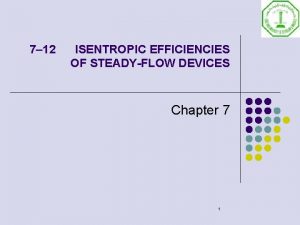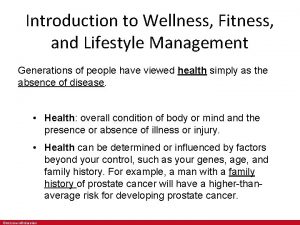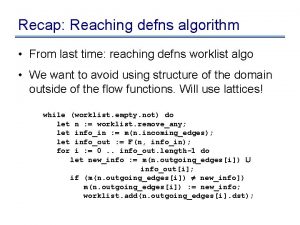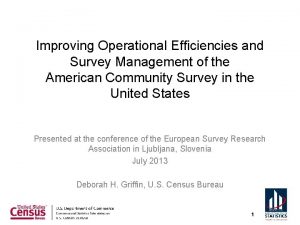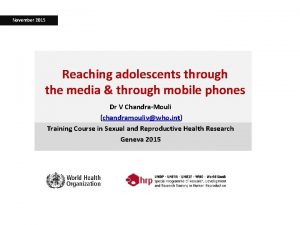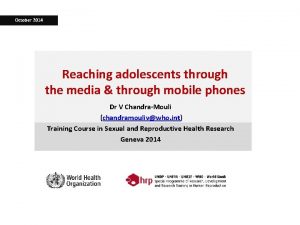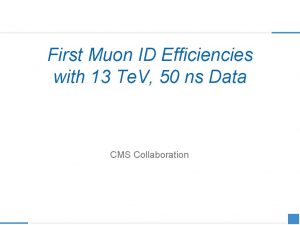Improving Technical Efficiencies Reaching the First 90 through























- Slides: 23

Improving Technical Efficiencies: Reaching the First 90 through Community Index & Sexual Network HIV Testing in Zimbabwe. A Muchedzi, N Mahachi, T Moga, T Tafuma, P Mawora, D Harbick, T Nyagura, K Reichert 24 th July 2018

Presentation Outline • Background – Zimbabwe HIV context – Progress towards 90 -90 -90 • Description – FHI 360 Zimbabwe HIV Care and Treatment (ZHCT) Project – FHI 360 Community Index HIV Testing Approach – Sexual Network Testing • Lessons Learned • Conclusion 2

Introduction: Zimbabwe HIV Country Context • Zimbabwe is in Southern Africa • Population: 13 Million (2012) • HIV Prevalence(15 -49): 14%* • HIV Incidence: 0. 48 in 2016 • Total PLHIV: 1. 3 Million* • PLHIV on ART: 1, 029, 719* * National HIV Estimates 2017

Zimbabwe’s Progress Towards 90 -90 -90 100 90 80 70 60 50 40 30 20 10 0 68 76 74 86 87 87 Diagnosed On Treatment Males Females 84 84 86 Virally Suppressed Total • Innovative approaches required for last mile • FHI 360 Zimbabwe HIV Care and Treatment (ZHCT) Project is responding with Community Index HIV and Sexual Network Testing 4

Zimbabwe HIV Care and Treatment (ZHCT) Project • Eight rural districts • Goal: To Increase access and availability of comprehensive HIV care and treatment services through community based interventions • Project compliments Ministry of Health efforts – Towards 90 -90 -90 – Ending AIDS by 2030 5

FHI 360 Community Index Testing Approach • HIV testing – sexual partners and children of index cases – Trained nurse at community level • FHI 360 strengthened community health system District Team Leaders (8) Trained Nurses (~ 40) Community Cadres (120) 6

FHI 360 Community Index Testing Process Community HTS initiatives 7

Nurse Tester Activities at the Household • HIV Testing and counselling • Integrated health symptom screening • Hypertension, Diabetes Mellitus, Malnutrition • Health education on HIV and health topics • ART Adherence counselling • Referral to health facilities for ART initiation 8

Successful Sexual Network Testing: The Case of Tinotenda • • SNT Process Nurses trained to explore SNT Consent to explore SN Case of Tinotenda 9

Summary of Tinotenda: Best Case of Sexual Network Testing Tinotenda • • 7 HIV+ identified (58% Yield) 7 initiated on ART 4 HIV – 1 Not tested for HIV • counselling in progress • Ages: 2 yrs - 50 yrs ~ 4 weeks ~ 230 km covered

Lessons Learned: FHI 360 Project Data Oct 2016 to Sep 2017 14, 818 Index cases identified 22, 147 Tested for HIV 330 Health Facilities 8, 367 Positive 38% Yield Rate 5, 771 Initiated on ART 69% Initiation Rate By Jun 18 Initiation Rate = 89%

Age/Sex disaggregation of People Reached Oct 2016 to Sep 2017 1 -4 • Males tested for HIV: 11, 754 (48%) • Adult men (>15 yrs): 10, 883 (93%) • Adult men identified as HIV+: 3, 705 (34%) 5 -9 10 -14 15 -19 20 -24 25 -49 50+ Female Male 12

Efficiency of Community Index HIV Testing with Sexual Network Testing: Apr 2016—Sep 2017 12, 000 2500 10, 000 2000 8, 000 1500 6, 000 1000 4, 000 500 2, 000 0 No. HIV Positive Persons No. Persons Tested for HIV Sexual network testing introduced 0 Apr-Jun 2016 Jul-Sep 2016 Oct-Dec Jan-Mar 2017 Quarters Tested HIV+ Apr-Jun 2017 Jul-Sep 2017 One HIV positive person identified for every 1. 8 index cases

High Yield Achieved on the FHI 360 ZHCT Project: Apr 2016—Sep 2017 12, 000 42% 39% 10, 000 50% 39% 33% 8, 000 30% 6, 000 16% 4, 000 2, 000 40% 20% 6% Yield No. of Persons Tested for HIV Sexual network testing introduced 10% 0 0% Apr-Jun 2016 Jul-Sep 2016 Oct-Dec Jan-Mar 2017 Quarters Tested HIV+ Apr-Jun 2017 Jul-Sep 2017 • Ave yield 38% with SNT Yield Rate • Yield in sexual partners 44%

Conclusions • Efficient – increased number of HIV+ persons identified • Achieves high and sustained yield • Reaching key subpopulations, – including men, – would not ordinarily access testing using traditional HTS 15

Next Steps • Expand the approach • Integrate HIV Self. Testing (HIVST) • PREP to high risk populations • Scale up Community ART initiation • Conduct cost analysis 16

Acknowledgements • • • PEPFAR/USAID Ministry of Health and Child Care ZHCT Project Beneficiaries ZHCT Project Staff AIDS 2018.

Contact details: Auxilia Muchedzi- ZHCT Project Deputy Chief of Party Email: amuchedzi@fhi 360. org www. fhi 360. org

BACK POCKET SLIDES 19

ZHCT Cascade Oct 2016 -Sep 2017 48% (11, 754/24, 601) were males, with a yield rate of 33% (3, 853/11, 754). 20

FHI 360 Community Index HIV Testing Program Quality Assurance Community Program implementation is guided by • SOPs • Job Aides • FHI 360 pioneered the development of • Community M&E system and tools • Community HIV testing quality assurance system 21

FHI 360/ZHCT HTS Cascade Oct 2016 to Sep 2017 3. 4% of clients tested were retesters. These were removed from the data reported here Av. 2 contact per index case followed up Yield rate: sexual partners (44%), children 17%, 22

Proportion of clients initiated on ART Cohort analysis showing time to ART initiation: Makoni vs Mutasa District, Oct 2017 – May 2018 100% 80% 60% 40% Makoni has more than 50% same day initiation but in 30 days they linked 90% by 30 th day 59% 82% 52% 85% 87% 90% 63% 63% 14 Days 30 >30 29% 20% No community ART 0% initiation in Mutasa 0 7 Makoni (Both Facility & Community ART initiation) Community ART initiation: initiating ART at community level through collaborating with MOHCC facility based or OPHID DSD nurses 23
 Isentropic efficiency of pump
Isentropic efficiency of pump Captive reinsurance for stop loss
Captive reinsurance for stop loss Ecological efficiencies
Ecological efficiencies Introduction to wellness fitness and lifestyle management
Introduction to wellness fitness and lifestyle management Bonnie tyler reaching for the infinite heart
Bonnie tyler reaching for the infinite heart Chapter 22 reaching out cross-cultural interactions
Chapter 22 reaching out cross-cultural interactions Strategies for reaching global markets
Strategies for reaching global markets Chapter 22 reaching out cross-cultural interactions
Chapter 22 reaching out cross-cultural interactions Chapter 22 reaching out cross-cultural interactions
Chapter 22 reaching out cross-cultural interactions Hinduism method of reaching paradise
Hinduism method of reaching paradise Reaching out from within
Reaching out from within Reaching forward to those things which are ahead
Reaching forward to those things which are ahead Reaching beyond yourself
Reaching beyond yourself When i found the joy of reaching your heart
When i found the joy of reaching your heart Reaching global markets
Reaching global markets By one man sin
By one man sin Classes of furcation
Classes of furcation Advantages and disadvantages of tangential sawing
Advantages and disadvantages of tangential sawing Nissim ezekiel night of the scorpion
Nissim ezekiel night of the scorpion Hình ảnh bộ gõ cơ thể búng tay
Hình ảnh bộ gõ cơ thể búng tay Lp html
Lp html Bổ thể
Bổ thể Tỉ lệ cơ thể trẻ em
Tỉ lệ cơ thể trẻ em Chó sói
Chó sói
